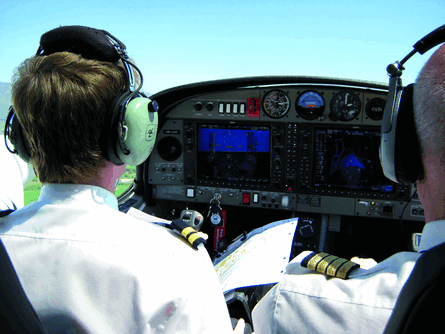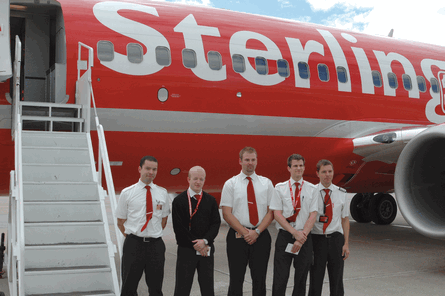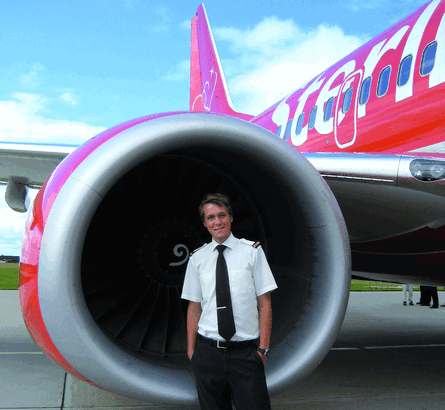Airlines have long resolved to free themselves from the cycle of famines and surfeits in pilot supply. The cause has always been a failure to invest in training until shortages arise, then the newly trained pilots arrive in time to be furloughed as the next economic downturn bites.
The latest air travel slump has been precipitated by a collapse of business and personal financial confidence caused by the global credit crunch, while simultaneously airlines are being squeezed by consistently high fuel prices: a particularly vicious combination.
The downturn may provide temporary relief - in one narrow sense - to the high-growth airlines of China, India and the Middle East. They have been saved, in the nick of time, from an otherwise inevitable severe shortage of experienced pilots. But now, for a few years, they look as if they will be able hire the recently sacked expatriate crews from the rest of the world, as carriers in the mature economies look everywhere for massive cost reductions.
 |
|---|
© Swiss Aviation Training |
European pilot training guru Peter Moxham, consultant to the European Council of General Aviation Support, gives his reaction to the suddenness of this latest change from pilot supply boom to bust: "For some years we have been talking about a pilot shortage, not just in the UK or Europe, but worldwide. We even saw low-hour pilots join the US carriers. Now it is 'stop'. I believe that the airlines have simply never had it so bad. Not just fuel [cost], but also a credit squeeze."
The gloomy current airline market may cast a long shadow over the training industry, but historic experience of market cycles combined with contemporary economic trends present a much more complex and - in the medium term - promising picture for the airlines and flight training organisations. The world's financial institutions will, in due course, sort out their self-created credit woes; the oil prices will find a level that the surviving airlines will learn to live with; the global economy will recover, and the human race will rediscover its irrepressible urge to travel. Meanwhile the training industry is being presented with new tools that will confer advantages not widely available now.
FAVOURABLE PROGNOSIS
Despite a favourable long-term prognosis, gloom dominates the industry, especially in Europe and the USA. At a human - as well as a systemic level - one of the most unfortunate recent victims of airline cuts have been the world's first multicrew pilot licence line pilots. Denmark's Sterling Airlines, working with the Center Air Pilot Academy (CAPA) and the Danish aviation authority, trained them to MPL standard and took them on to the line in September 2007. Despite finding that the new first officers performed particularly well, Sterling has now had to lay them off. This has led Moxham to ponder: "What responsible company will go down the route of recommending the MPL now?"
Regional airline Danish Air Transport is doing just that, but not in large numbers. As Sterling had done before it, Danish Air Transport, which operates a fleet of ATR 42s and 72s, took on four CAPA-trained MPL graduates on 23 July. The carrier's head of training, Capt Lars Riis, says the new first officers are highly motivated, disciplined, extremely good at cockpit resource management and in their practice of standard operating procedures.
 |
|---|
© Sterling |
The first officers are undergoing their line operations flight checking. In September, he says, the carrier will select two more student pilots who will have reached the final part of their generic instrument training in a flight and navigation procedure trainer for instruction to MPL for its ATR fleet, and they should be on the line by about December.
Zurich-based Swiss Aviation Training carries out more pilot training to MPL than any other European flying training organisation. It began preparing its first ab initio candidates for MPL in April 2007, according to chief instructor Rolf Eickstaëdt, and the first graduates will join their airline later this year.
These trainees consist of pre-screened candidates chosen and sponsored by Swiss International Air Lines, says Eickstaëdt. Swiss Aviation Training, he says, runs four courses a year with about 24 cadet pilots on each. The courses begin every three months, and alternate between courses that train pilots to MPL or to a commercial pilot's licence with instrument rating. All the MPL students are bound for Swiss, and the CPL/IR courses cater for a mix of self-sponsored students, trainees for Swiss, and pilots bound for the Swiss air force.
 |
|---|
© Swiss Aviation Training |
In December, says Eickstaëdt, some CPL/IR and some MPL students from Swiss Aviation Training will join the airline for type rating training. This, he says, should give Swiss an opportunity to compare the products of the two different streams because, at the selection stage, they were all tested against the same criteria. Eickstaëdt says that Swiss has not indicated an intention to reduce its student intake, but makes no predictions about what the future holds.
Moxham, however, says the training industry is nervous about the short term. CAPA's Jens Frost says airlines "are not planning more than six months ahead" for recruitment and training, and Danish Air Transport's Lars Riis confirms that is the way his airline is thinking. Moxham says: "Many airline prophets are forecasting doom and despondency many forecast more bankruptcies and mergers. If we the prophets are right - and they may be exaggerating - then there will be a significant pilot surplus. Taking the proposed cut in aircraft numbers this winter - claimed to be winter only but I suspect it's more permanent than that - the number of pilots furloughed will run into hundreds in the UK alone, and the UK is not unique."
WORLDWIDE PROBLEM
Moxham adds: "I have also to question whether this should be considered a European or a North American problem, or whether it is a worldwide situation. I do not believe any country is immune since all rely on international travellers. Emirates may be booming, but if things get tight in Europe then their load figures will inevitably decline - the same applies elsewhere.
"Worst affected will be those carriers with old-technology aircraft that are simply not competitive on fuel burn. The manufacturers have massive orderbooks, but it seems inevitable that customers will slide deliveries to the right, and this will only accentuate the problems."
How will this affect flight training organisations? Moxham says: "All my information is that the larger FTOs are actually expecting a severe downturn in business for 2009. Fuel will mean price increases, and the credit crunch reduces the amount of funds the banks will lend for training." His comments, he says, are based on "industry discussions over the past couple of months".
This contrasts with the situation as seen only a few months ago by Swiss Aviation Training. In April, the organisation's chief executive Manfred Brennwald had the luxury of worrying about the prospect that the entry barriers to becoming a pilot would be lowered as a result of the global pilot shortage and the rapid growth of air transport, making pilots "just another commodity".
POLISHED IMAGE
The industry, he said at the time, has a responsibility to "polish the image the pilot profession has", and ensure quality students are attracted to an airline flying career. For that reason, said Brennwald, Swiss Aviation Training had no plans to grow its ab initio training into a global business with flying schools in emerging economies.
Boeing's worldwide training organisation Alteon, however, released figures in July that, if borne out, suggest the long term will be more benign for the training industry, and that the airlines had better not get complacent about having enough pilots for the time being. Demand for pilots and aircraft maintenance specialists over the next 20 years will be at a level that the training system would not be able to meet, according to Alteon's president Sherry Carbary.
Alteon forecasts that, from 2007 to 2027, airlines will take delivery of 29,400 new aircraft to replace old fleet and cope with the growth in demand for air travel. This, says Carbary, will require an average of 18,000 new pilots and 24,000 maintainers a year to be trained to replace those who retire and also to crew and service the increasing numbers of aircraft in the world fleet.
Only by training at those annual rates will the industry be able to meet the estimated need over the next 20 years for a total of 360,000 new pilots and 480,000 new maintainers, Alteon calculates.
North America heads the league in terms of the number of pilots it will need in the next two decades, at 98,000. Europe follows at 70,000. Other regional predicted requirements are: China 49,900, South- East Asia and Indonesia 32,000, Latin America 22,800, Japan 19,000, the Middle East 17,500, the CIS 11,500, Africa 10,100 and Australasia 7,200.
RULES CHANGES
Meanwhile, new proposed rules for European flightcrew licensing threaten to throw much of the continent's pilot training industry into chaos, at the same time closing associated training organisations in the USA and damaging US-owned flight training/type rating training organisations based in Europe.
A group of eight major European flight training and type rating training organisations have jointly signed a letter to the European Aviation Safety Agency protesting about its current notice of proposed amendment to the existing JAR flightcrew licensing (JAR FCL), which would radically change many of the ground rules defining how a training organisation must conduct its business to be approved to train pilots for an EASA licence.
EASA's rulemaking has to comply with basic European Union law. EASA interprets this as requiring that approved flight training organisations shall be based in Europe, will conduct the critical phases of training and the final flying tests in Europe, and shall be owned by companies whose main base is in Europe. At present most major European training organisations rely on a significant part of their students' actual flying training taking place abroad, mainly in the USA, using instructors that have a US Federal Aviation Administration licences even though they are training to an EASA/JAA syllabus.
The proposed rule would disallow instruction by pilots who do not hold at least the same level of European pilot's licence or rating for which they are preparing their students, plus an instructor's or examiner's rating. At present instructors in the USA, or at training bases in non-EU countries, do not have to hold European licences if they are licensed as instructors in their own countries and are training the student pilots to a JAA-approved syllabus and testing regime.
A completely European alternative would have to be found, according to Moxham. Training organisations that have written to EASA say there is no certainty that this could be achieved at all, let alone in time for the rule's adoption in 2009 and implementation in 2012.
The effect of the regulation would be to strengthen the Europeanness of the requirements which, if adopted as proposed, would make the European flightcrew licensing requirements like an eastern Atlantic version of the FAA licensing rules.
GETTING THE MOST OUT OF NEW TOOLS
Ever smarter, ever cheaper flight training devices for tailoring pilots to the needs of modern airlines operating highly efficient, highly automated aircraft are among new tools becoming available to the training industry.
The relatively new multi-crew pilot licence, as opposed to the traditional commercial pilots' licence/instrument rating (CPL/IR), is designed to get maximum benefit from the new devices and advanced full flight simulation, and the MPL course, unlike the CPL/IR, contains an integral IR.
The licence is not complete until the pilot has passed his/her type rating training for the sponsoring airline. It is gained via an International Civil Aviation Organisation-specified performance-based course designed to confer traditional aviation skills and knowledge, but also the crew resource management and the threat-and-error-management skills needed by airline pilots.
This contrasts with the skills needed by lone aviators, which is what the traditional CPL/IR course is designed to produce.
ROCKY START FOR MPL IN EUROPE
Forced by the economic downturn to cut its pilot workforce by 61, Denmark's Sterling Airlines had to dismiss its nine multicrew pilot licence first officers, the only pilots anywhere with this new qualification to have reached line flying.
Their dismissal had nothing to do with their skills, the airline confirms, but the carrier was applying the last-in, first-out principle that most operators employ when faced with the need for redundancies.
Sterling admits that the MPL first officers have aparticular problem in finding alternative jobs because they were trained specifically to Sterling's standard operating procedures and have a licence of which other airlines have no experience.
 |
|---|
© Sterling Airlines |
The first four MPL co-pilots began line flying with Sterling in October last year. Chief training pilot Capt Per Lilja says they had completed line acceptance flying from the carrier's Oslo base within 22 days, having flown 49 sectors, and were coping well with Norway's winter operating conditions.
Now they are out of work, as are the second MPL batch of five graduates fostered by Sterling, working with the Center Air Pilot Academy (CAPA) and the Danish aviation authority. CAPA's type rating training instructor for the MPL course Capt Jens Frost says they could work for another airline following nothing more than an operator conversion course - a normal practice to familiarise any pilot with an airline's standard procedures - but the lack of familiarity of other airlines with the MPL concept is proving an obstacle in practice.
Frost admits that one of the options the MPL first officers are having to consider is converting their MPL to a traditional commercial pilot licence and instrument rating (CPL/IR), which would entail gaining 30h more time as pilot in command, and about 15h flying in a Piper Arrow or similar type to prepare for the single-pilot skill tests that the CPL/IR demands. Frost says there are, at present, practically no single-pilot commercial jobs, but at least the pilots would have gained a qualification with which most airlines are familiar.
But, on the other side of the world, where Boeing's training company Alteon has been working with the Airline Academy of Australia to train pilots for two Chinese carriers to MPL standards, Australia's Civil Aviation Safety Authority (CASA) has just decided to embed the MPL into its national aviation regulations, releasing a notice of proposed rule making to that effect a fortnight ago. This announcement came as the first batch of students undertaking Alteon Training's beta test of the MPL in Australia are in the final stages of training.
CASA plans to implement the MPL according to International Civil Aviation Organisation standards and recommended practices: training will comprise four stages - core flying skills, basic, intermediate and advanced - with crew resource management (CRM) and threat and error management (TEM) in all phases of training, and the extensive use of flight simulation and training devices.
Australia is proposing that an MPL applicant should meet the minimum flight experience standards published by ICAO - 240h of flight experience including 40h as a pilot in an aircraft, 10h solo in an aircraft including at least 5h of cross-country flight time and the rest in synthetic training devices.
It does not appear to be CASA's expectation that its own carriers will necessarily take up the MPL. The authority says that since airlines in Asia, the Middle East and Africa like training their pilots in Australia, if it does not offer the MPL option it will lose training business opportunities.
CASA says it is committed to the concepts underpinning the MPL and backs the need to evolve pilot training through the use of modern simulation technologies, better training practices and the further adoption of CRM and TEM. The authority plans to review MPL implementation on a six-monthly basis for the first two years and conduct a post-implementation validation check within that period. Newly qualified MPL pilots will be closely monitored, says CASA, and it will require them to complete 12 take-offs and landings in the actual aircraft before starting line operations, as recommended by ICAO.
Alteon's proof-of-concept MPL beta test trial started in March 2007. Now, six students from China Eastern and Xiamen Airlines are undergoing their Boeing 737 type rating training on simulators at Alteon's Brisbane facility having completed their MPL flying training with the Airline Academy of Australia. The students are due to complete their MPL in early November, says Alteon.
The academy's chief executive Stewart Cameron concedes the jury is still out on MPL in Australia, but believes the concept is work ing well. Alteon's parent company Boeing plans to decide on its future investment in MPL training after completing this pioneering course.
Blogs:
Forums:
Source: Flight International
















